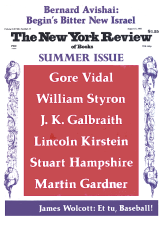In response to:
In the Museum of Strangeness from the March 19, 1981 issue
To the Editors:
As usual I was enlightened by Michael Wood’s latest review [NYR, March 19] in which he used Marcel Jean’s book and my own as a springboard for a discussion of Surrealism. Once again his command of the material, his fresh views, and his commitment to revealing the social truth of art without trivializing it revealed his critical mastery.
I was all the more surprised by his flippant method of passing judgment on From Enchantment to Rage: The Story of Surrealist Cinema. He writes that the book lacks sophistication and cites two isolated sentences from the text as evidence. Let me place those statements once again in their contexts.
“Dalí’s fixation on the womb is a rather pronounced one” belongs to a psychoanalytic profile of the artist, which had not been attempted prior to the writing of the book. The quoted line introduces a series of specific examples from Dalí’s life and art, including intrauterine memories from his autobiography, a photo of him within an egg shape as an adult, nude and in the fetal position, and the planned womb-like ambience of his house in Port Lligat. But the recurrence of the image of the womb points to his dependence on the maternal womb in a larger, more symbolic sense. As a young man his narcissistic excesses led him to self-mutilation and brought him to the brink of a mental breakdown. It was his wife Gala alone who saved him from his own self-destructive tendencies. Dalí has repeatedly acknowledged her role as his maternal protector ever since. Therefore his specific and symbolic obsession with the womb is a significant factor in understanding his art.
“Being so close to death, members of the Dada-Surrealist circle had to indulge in black humor as a safety valve” is the concluding sentence of a paragraph discussing the way in which their black humor issued from their outrage against the Great War. Among the millions of young men killed, the Surrealists counted a number of their close friends. The senseless brutality of the war, in fact, precipitated their resolute opposition to bourgeois society. They continued to be haunted by death through the 1920s, for no less than three of their group, Jacques Vaché, Jacques Rigaud, and René Crevel, committed suicide. Yes, black humor was a necessary safety valve for these men whose profound alienation from society made them question their own existence. Their fervent espousal of “l’amour fou” was in itself an extreme affirmative reaction to their underlying nihilism.
These are the arguments, condensed from the book, which should have been discussed, rather than isolated sentences. I am accustomed to seeing those one-liners wrenched from the text in the movie display ads of the entertainment section of our daily newspapers, not in the columns of The New York Review of Books. And that they should appear as an attack on sophistication!
Steven Kovács
Woodland Hills, California
Michael Wood replies:
Mr. Kovács’ letter confirms my original view. It was his arguments I found lacking in sophistication, not simply the isolated sentences I chose to illustrate them. I wasn’t trying to be flippant, and I wasn’t really complaining. I was trying to suggest what could be found in Mr. Kovács’ sensible and engaging book, and what could not.
This Issue
August 13, 1981



